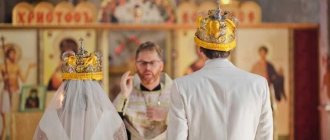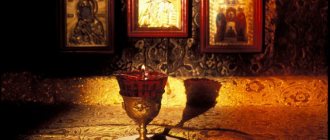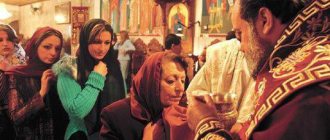Taking photos ruins the atmosphere
At the legislative level, there is no ban on photography in churches, but some churches can set restrictions on their own. And it’s not some personal reasons that push them to do this, they just don’t want the special atmosphere to be disturbed.
Just imagine, you are standing in front of an icon, praying or thinking about something, you are extremely focused, and suddenly your thoughts are interrupted by the sound of a shutter or a bright flash. Nice? To put it mildly, not very much.
After all, people come to church expecting an absolutely calm and peaceful atmosphere to reign there, where no one bothers anyone. Therefore, this is a very good reason for banning photography.
Is it forbidden to take photographs in the temple?
This year my family and I traveled around Crimea and visited many churches and monasteries. Of course, I wanted to take photographs as a souvenir, but almost everywhere there were prohibitions. In one monastery it is forbidden to take photographs near shrines; in many churches photography is prohibited during services. Is this ban justified? Fedor
Answers priest Igor PALKIN, cleric of the Church of the Martyr Tatiana at Moscow State University, photographer: “The Acts of the Apostles tells how the shadow of the Apostle Peter healed the sick who lay next to the road along which he walked. A shadow is also a photograph. And in the most literal sense - a drawing made by light. Today there are known cases of myrrh-streaming of icons made in a typographic way. That is, these icons are also based on photography.
Therefore, of course, you can photograph shrines. The purpose of such photographs is to preserve the memory of places where we touched grace. And when we feel bad or discouraged, looking at these photographs may well strengthen our faith or encourage us to pray. Why is photography not allowed in many churches and monasteries? There are several answers to this. The temple is a place of prayer, and the ban on filming during worship indicates exactly this. It’s not very good to interfere with the prayers of several dozen people by walking and outbursts. Even if there is only one person in the temple, his prayer is more valuable than a wonderful photo exhibition.
A monastery is not just several churches, but also a place where monks live - people who have left the world for the sake of prayer. For them, the monastery is a home in the most literal sense. Probably, few people will like it if they take pictures of him in his apartment without permission? Therefore, it is better to take a blessing for the shooting. True, sometimes they offer to buy a blessing (I was personally offered). This, I am sure, is unacceptable. Of course, it is necessary to explain to pilgrims the meaning of sacrifice and encourage them to make it, but not force it. His Holiness the Patriarch spoke about this repeatedly at diocesan meetings. Photography is also often not allowed for security reasons. The bishops of ancient dioceses and the rectors of old churches know firsthand that thefts of shrines are often preceded by photography. Alas.
What to do if you were unable to get a blessing from the abbot or the service is going on and it’s time to leave? Go to the bookstore. There are almost always photographs, postcards or books about this holy place on sale. Moreover, the photographs in them were taken by professionals at different times of the year and will certainly be of better quality than you take yourself in five minutes. For example, this is exactly what I do. And if there is nothing in the store, put everything you saw in your heart, and the Lord will completely comfort you for your peaceful heart and humility.
Prepared by Leonid VINOGRADOV Photo by priest Igor PALKIN and Thomas magazine
Filming causes damage to frescoes
Taking photos in churches may be prohibited due to the fact that this may negatively affect the condition of ancient frescoes and icons. The process itself, of course, has no effect, but an outbreak is quite capable of causing harm.
Despite the fact that the pulse lasts for a few fractions of a second, it still hits the surface, it starts a chemical process, due to which the object begins to deteriorate faster. Therefore, in some churches there is a ban, for example, in the Sistine Chapel, famous for its amazing ceiling with Michelangelo’s cycles.
Fortunately, technology has come a long way now; you can take great pictures without a flash. Therefore, the chances of capturing beauty have become much greater.
[Situation #19]
Where is photography really prohibited?
First of all, this is filming in court buildings and correctional institutions.
Such prohibitions are established by the relevant procedural codes, which have the force of federal laws.
- Abandoned buildings
Don't do
a photo shoot in abandoned buildings
. And just don’t take pictures in front of them. This process will take away vitality, provide attachment to the place and reduce your energy level. - Cemetery
And in such a creepy place there are people who want to take photos against the backdrop of the graves of the dead. Even one photo can tie you to this place. You can get very sick later. - Sleeping people
They say that sleeping people are more susceptible to the negativity that is transmitted through photos. And if the photo falls into the hands of an ill-wisher, it will be much easier for him to cause damage. - Mirrors
Don't take pictures of yourself or other people in mirrors. As you know, these objects are capable of storing all the events and energy of the people who appeared in them. The reflection photo draws onto you all the negative energy of those who looked at themselves in the mirror before. - Waterfalls
Experts say that taking a photo with a waterfall in the background can seriously harm you. After all, a strong stream of water can take away all your vitality. The result of this action can be the saddest. - Children under one year old
Do not photograph children under one year old, and ideally before baptism. And if you can’t resist taking a photo of a cute baby, don’t show the photo to strangers. After all, children are absolutely defenseless against any energy strikes. - Store photos correctly
Do not mix photos of living and dead people in the same album or folder on your computer. In this way, you will create chaos by mixing different energies, and this will worsen the well-being of the living. If your loved one is on the verge of death, then do not constantly hold his photo in your hands, and also remove it from a prominent place if possible. Otherwise, when he dies, he will not be able to calmly go to another world. Such is the mysticism. - Personal photos
Of course, it’s difficult to imagine modern life without
publishing photos on social networks
. But try to minimize this matter: fewer photographs with your family, with material wealth... Especially if you know that there are people who wish you harm. For example, you are a very rich person or you work in government. - Destruction of photographs
Do not tear, do not pierce with needles, do not cut or burn photographs - all this causes damage to the person depicted on them. Do not take sin on your soul, even unconsciously. - Photos under the clock
They say you can’t put photos under the clock. This shortens a person's life span.
by Alexandr Marynkin
In the process of working, photographers have to communicate with a variety of people, which means they have to deal with an incredible number of signs, beliefs and superstitions. It’s good if a person is engaged and the only important thing for the customer is that the numbering of product photographs does not contain the number 666 or 13, but how do wedding or children’s photographers get out? For example, there is a belief among ordinary people that it is impossible to photograph sleeping people, because it is believed that during sleep a person’s soul flies away from the body, and if you take a photograph at this moment, then all sorts of sorcerers, witches, sorcerers and other magical powers can use the photograph image to impose a curse, spell, love spell, conspiracy and other witchcraft things, which, undoubtedly, harm a living person.
Unfortunately, there are no statistical data on this matter. And it is impossible to say with a certain degree of probability that they took a photograph of a sleeping person, and something irreparable happened to him. But this one is alive and well only because the parents at one time did not allow “sleepy photographs” to be taken when the child was sleeping. That's why photographers need to understand and know some superstitions in order to do their job and, in particular, take cute, good photos of sleeping babies.
by Oleg Marchenko
Modern superstitions arise from coincidences and alterations of old superstitions. They are often borrowed from other cultures, especially now that the world has become a much smaller place thanks to television and open borders. The older people are, the more they acquire (on average) signs and superstitions. you have to not only be well versed in human prejudices, but also know them well, be prepared in order to be able to dispel mystical doubts in time.
by Nathaniel-Smalley
For example, when beautiful photos of newborns appear that evoke tenderness in viewers, the myth disappears by itself!
And if we consider wedding signs, then it is generally the duty of every sane photographer to combat them, because a wedding is a delicate matter and the approach to the participants of the celebration must be extremely careful.
Let's look at the most common wedding signs and think about what to do with them so that they don't complicate photography.
- You cannot photograph the bride alone.
In fact, this is complete nonsense from bride-to-be mothers. The girl dreamed of her wedding day, to be a princess, but one cannot deprive her of the opportunity to have beautiful portraits, which will then motivate a person to be beautiful and extraordinary for many years to come!
- If you don’t pay the photographer, the mother-in-law’s husband will go to his mother-in-law.
The real truth! All kinds of troubles will befall the one who decides not to give the promised fee for photography.
- You cannot photograph young people against the backdrop of churches.
In this case, it is necessary to clarify what religion the bride and groom profess. It is likely that for them it does not matter at all what is in the background, the main thing is that the photograph is beautiful. Otherwise, the temple must correspond to the religion of the newlyweds.
- In general, you should not photograph newlyweds on their wedding day.
These are obvious machinations of videographers.
- If you feed a photographer at a wedding, then this will lead to good photographs.
Quite a logical conclusion. The main thing is that it needs to be conveyed to the head of the special event in time.
- No one should wear black to a wedding.
This cannot be understood, it just needs to be remembered. Please note that even a photographer can be kicked out for wearing a black T-shirt.
- The bride should not let go of the bouquet until the end of the wedding.
by Marcel Sander
History is silent about the essence of this sign, but it is easy to fight it. Explain to the bride that all photographs will be the same. The bouquet can be held by an uninterested, especially trusted person, for example, a photographer's assistant.
- No photographs can be taken between the bride and groom.
It’s impossible, it means it’s impossible! Here, as they say, there is a third wheel.
- You can’t get married in May - you’ll be tormented all your life.
And if you get married in April, you will be in April for the rest of your life! But in fact, the photographers themselves came up with the sign. There should be a vacation for freelancers at least someday.
- You cannot take pictures of the bride in the mirror.
by Sergey Minnigalin
Some of the best photographs are usually taken with reflections. To convince the bride of the pointlessness of this, ask: “Shouldn’t you exchange the SLR camera for some kind of point-and-shoot camera?” Such statements usually sound very threatening.
- The bridesmaid must kiss the best man.
Quite a good omen. If the girlfriend is pretty, then she will also be with a photographer, if not so much, with a cameraman.
- You cannot photograph young people standing on opposite sides of the tree.
Don’t bother with this, they will tell you themselves if they believe such nonsense.
- A special gem can be considered the idea of one mother of the bride that you can’t take photos of young people if there is a building in the frame: the brains of young people will turn to stone; if there are trees: the legs will fail; and in general - in Ancient Rus' they did not take pictures and lived happily.
You can’t particularly object to the argument that it was in Ancient Rus', but the main task of the photographer is still to ensure that nothing sticks out of the newlyweds’ heads in the photographs. For this you can get the first number and, in the worst case, even lose your fee.
- The first photo of the bride in her wedding dress should be with her mother or groom.
A wonderful sign! It’s worth shouting: “Cheers to your health!”
Naturally, do not forget to come up with signs yourself. For example, they say that everyone you photographed lived happily ever after and only one of them got divorced because they didn’t pay the advance. This will add points and +20 to the beauty of your portfolio.
In general, other signs help very well against omens. You just need to remember to tell your grandmothers, mothers-in-law, and mothers-in-law that you have a lucky lens, a special wedding card, and in general the best friend for the stability of young relationships.
There was a sign that you should never take pictures with a guy. But it quickly became obsolete and is now almost never voiced.
But there is another one - it is much more popular, older and many people still believe in it - if future newlyweds are going to unite their destinies through a wedding, photography can destroy their entire marriage. Let's look at this particular sign in a little more detail.
If a couple of lovers not only already have the idea of getting married, but they are actively preparing for it and can’t wait for this moment, even one photo can cause separation.
Although many people are skeptical about this, there are many examples of mothers and then their daughters being left alone because of this. In the best case, a long separation may occur, at the end of which the couple will be together again. At worst, the groom can ask for the bride directly at the registry office.
Despite the fairly large number of stupid superstitions in our world, this one has a more or less stable explanation.
I am sure that many people know this sign: along with a photograph, not only a piece of your energy is transmitted, but also a piece of your own soul. Now imagine that your photo with a guy (and this superstition applies directly to the female sex) “went from hand to hand.”
And, unfortunately, in our lives not very good people will come and, fortunately, leave. They will get angry, jealous and slander you when they look at your photo. And they don’t have to say it out loud. Just a thought, a desire, even an unconscious one, is enough.
We also all know another popular (due to the fact that it has been repeatedly proven in practice) sign that thoughts can materialize in some mystically amazing way.
As you know, in the subconscious a person, even the most skeptical, begins to fear that some bad omen may come true when he learns about it. And as you know, if you don’t forget about it, but think for a long time, worry and get nervous, and don’t find peace because of it, it will definitely come true. The author is sure that this happens to every person at least once: what we think about with caution inevitably comes true. It’s the same with this sign.
Then how can you protect yourself if you have already taken a photograph, and only later found out about this superstition and cannot find peace for yourself?
There are two ways by which you can ward off evil forces and the evil eye from yourself and your photographs.
- The first of them is to take your photograph (it is advisable to take all the photographs in which you think there are evil forces), sprinkle holy water on it and say three times “Not for bad, but for good, not for separation, but for living together. Truly!”, then hide this photograph in a secluded place so that neither the future wife nor the groom sees it before the wedding.
- The second way is to repeat the following prayer every day, when the sun is about to set (in the afternoon or evening), 40 days before the wedding, holding a photograph before your eyes: “The people of God gather for Holy Easter, looking at golden crosses, golden bell towers. But they don’t look at my image, they don’t know, they don’t know. Amen". Moreover, in both methods it is not necessary to destroy the photograph.
There are many different signs and superstitions associated with photographs, many of which came from other countries and are firmly rooted in our consciousness. For example, some peoples around the world still believe that the one who takes photographs takes the soul. That is why in these states and in remote Russian regions it is prohibited to film the local population without the special permission of each individual person.
And only if in several photographs belonging to different time periods there are some sort of overexposed areas and other damage to the image, is it worth going to the clinic and undergoing a full examination.
In addition, the location of the stripes and spots must be taken into account - if they are located on the person himself, that is, on his face, neck, arms, legs or torso, then the problem really lies in the state of health. If the image around the captured person is damaged, then the threat to well-being comes from the external environment.
The photo where a person is depicted next to someone who is no longer alive has become blurred.
The situation when a photograph suddenly changes in clarity or fades, in which someone is captured next to a person who has already died, is quite rightly considered a negative sign. This suggests that the living person is in some kind of danger, and that he needs to be more careful.
However, several points should be taken into account here. Firstly, if such a photograph is placed where direct sunlight often hits, then it simply fades, and accordingly becomes cloudy or lighter. Secondly, Polaroids (snapshots) do the same thing over time without outside help, without sun exposure. And, thirdly, the only option that can be considered a bad omen is when the effect of overexposure or turbidity is observed exclusively in the image of a living person, while the image of someone who has already died remains untouched.
This sign has a good reason - through photography you can harm a person, send damage, illness, and misfortune to him. Photos are often used for love spells and other magical rituals, and a photo buried in a cemetery with corresponding curses can generally cause a quick death.
However, this all applies to photographs that are printed from a real negative or from the first media (from a digital camera, from a phone, from a tablet), and this sign does not apply to photos downloaded from the Internet and copied from social networks.
You cannot give a photo to your loved one and ask for his photo.
This sign is also easily explained - a photograph in which a person is depicted alone carries the energy of loneliness. Therefore, if such a photo gets to someone you want next to you as a life partner, he begins to subconsciously perceive you as a person who does not need anyone.
Moreover, nowadays it is customary to give the most successful, and sometimes edited photographs and even artistic photographic portraits in which the person is much more attractive than in life. That is, as a result, you may lose to your own double (display) if the comparison turns out to be not in your favor.
But if you still want to have a captured image of your loved one before your eyes, and he has yours, then it’s better to take a photo together. This unites and makes lovers think more often that they are a couple, and the energy of love, clearly felt in the photograph, distracts from the shortcomings of the face or figure.
You cannot tear up or burn your photographs.
Photographs are in some mystical way closely connected with the people who are depicted in them. That is why it is believed that if you burn or tear up your photos, then you disrupt the smooth flow of your life and attract illnesses and other troubles to yourself. That is, you destroy the integrity of the energy field of the photograph, and this immediately affects your real existence. So it’s better not to take risks and not to destroy even those pictures that you don’t like. By the way, this also applies to photographs of other people.
You cannot put your photograph in the coffin of a deceased person.
This sign was born from information about some rituals practiced by black magicians, and in fact, it also has a real basis. Many rightly believe that the one who “goes to the next world” with the deceased will indeed very soon be united with him.
Not to mention the fact that, perhaps, in almost every family album there is such a photo: mom, dad and baby in the middle. So what, every child went to another world? Naturally not.
If the photo turns out blurry, it means the person will soon get sick.
This superstition is especially made fun of by those who have at least once taken photographs on their own. The clarity of a photograph is influenced by a huge number of factors - from the skill of the photographer and lighting to hands shaking for some reason. Even professional “paparazzi” who use expensive cameras occasionally take blurry pictures. So a blurry photo has nothing to do with future diseases.
If you take a picture of a pet, it will soon die.
If this “sign” had worked, then for a long time there would have been practically no tame animals left on earth, only wild animals and lucky ones would have survived, who, due to a misunderstanding, were not caught in the camera lens of their owner. After all, all the people who adore their pets not only regularly photograph them, but also post their photos on social networks and send them to magazines for various competitions.
If you take a photo before a long journey, you won’t come back.
Another superstition. Remember how many photographs depicting famous travelers, sailors, astronauts, and politicians setting off on their journeys end up in newspapers and on the Internet. And how many of them experience fatal accidents? Statistics confidently refutes this “popular superstition”.
As you can see, many signs have so many assumptions that they come true only in extreme cases, and superstitions generally do not stand up to criticism. So take photos to your health and don’t look for negativity where there is none. The main thing is not to throw away your photographs and your children’s, and also carefully choose places for shooting, and then the photos will bring you exceptional joy.
Photography disturbs priests
Not only parishioners suffer from the abundance of people who want to photograph every centimeter in the church. This also bothers clergy, especially during various events.
People coming to a church service begin to get distracted and experience negative feelings, because not everyone wants to be in the frame at such delicate moments. All this interferes with a full and calm service.
Prohibitions on photography do not apply everywhere; almost all churches treat this favorably. But if you want to take photographs, turn off the shutter sound and do not use the flash, and also do not forget to first check with the priest whether it is possible to take photographs in a particular church. If you can’t, please be kind enough to observe the ban and treat it with respect.
Subscribe to our Yandex Zen channel and give it a thumbs up!
Why can't you take pictures in front of a church?
In newspapers, magazines, and books published directly with the blessing of metropolitans and archimandrites, there are many photographs of people against the backdrop of churches. Inside the Temple, you can also photograph festive events such as baptisms, weddings, and other celebrations, taking blessings from the priest who will lead the service or the rector of the Temple. All kinds of speculation and prejudice are superstitions not approved by the Church. If you want to photograph the interior decoration of a room or a person near the icons just as a souvenir, then you need to do this when there are no services, be sure to obtain the permission of the priest and get his blessing. God bless everyone!
Source: employee of the Temple of the Kasperovskaya Icon of the Mother of God.
You know, I didn’t find anything about this.
And as long as I’ve been living, for 24 years now, I’ve always been photographed against the backdrop of churches with my mother, with my loved one, and everything was very good.
But in order not to be photographed in the church itself - I have heard and hear this often. Many churches even prohibit photography in the church.
And against the backdrop of a church it might just be superstition. And someone confused it with taking photographs in the church.
I haven’t heard that you can’t take pictures near churches and temples. I even took pictures near the monastery, and the abbot of the same monastery did the same with the pilgrims; he didn’t tell us anything that it wasn’t allowed. Photos are memory, and temples are our cultural heritage. But in the temples themselves, private photography is not allowed, you can pay a fine for this, and the police can even be called. I remember the story of one blogger who caught Pokemon in a church. There are a lot of old utensils inside the church and it is not known where your photos will go, and whether these utensils will remain in place, and all your flashes and posing will definitely disturb other parishioners, which is unacceptable. You can take photographs inside the temple when you have received permission from the priest, for example, for the Christening of a child.
See also: Murygino Church
It seems to me that nothing bad can come from taking photographs with churches in the background. This is not prohibited in religion, and many of us have photographs in our archives against the backdrop of various churches. And these photographs are always looked at with inspiration; they seem to carry some imprint of the holy places depicted on them. They say that photographs can capture not only material objects, but also their spiritual component, the soul. Perhaps something similar happens with photographs of churches. Therefore, it seems to me that they should not be afraid to take photographs with churches; on the contrary, it is good, and such photographs can become moral support and fill a person with calmness and confidence.
This is the first time I’ve heard this, I’ve been working in the church for 20 years, and my choir and I often take pictures against the backdrop of various churches. And so far nothing has happened to anyone. I think this is some kind of new superstition invented, I don’t know why.
They say that sometimes you should not take photographs of the property inside the temple. When we were in the New Athos monastery, they weren’t allowed there. True, many people took pictures little by little: how could one not capture such beauty? Sometimes it is also worth asking permission from a clergyman. And against the backdrop of the temple it is not forbidden. And why not, in fact, create a frame against the backdrop of a holy building, be it a cathedral, temple or monastery? It is both beautiful and majestic, and certainly does not carry any negativity in any way.
You can also hear that photographs are not taken against the backdrop of waterfalls or mirrors, supposedly this takes away strength and energy. It is not clear what such superstitions are based on. And a mirror is not only a good “backdrop”, but also a modern way to take something like a “selfie” with your image. Probably, such nonsense should not be given importance.
Selfie as a sign of pride
To begin with, it is worth noting that opinions on this matter differ. Deacon Nikolai Andreev believes that there is nothing good in this action. You can be absolutely sure that such mania just signals the presence of this defect. Previously, a photographic portrait could be taken with a professional camera, but this process was not easy: after lengthy preparation and settings, you had to position yourself in front of the lens as quickly as possible, either alone or with friends.
When it comes to selfies, everything is simple. You don't even need to buy film. A person takes pictures anywhere and anything. Moreover, signatures, as a rule, begin with “I”: “I’m at school...”, “I’m with friends...”, “I’m at the sea...”, “I’m sleeping...”, “I’m eating...”. How far can all this madness of pride go?
A culinary delicacy that has become a trend. How to make citrus marmalade
Nikita Efremov said that he does not want to “put the collar on himself” of another marriage
My grandmother passed away, and 9 days later a strange red kitten came to our house
Why can't you put photographs next to icons?
A photograph, painting, image of any person is a reminder to oneself of his, perhaps already in the past, existence. This is the desire for his presence in a person’s life, his peculiar observation of a person’s worldly actions.
The image of saints has almost the same meaning for a person. They turn to saints for help, and to significant people too, even if only mentally. The presence in the life of a saint, like a loved one, is pleasant and provides an understanding of a kind of security and support. Based on this, many put photographs of loved ones on a par with the faces of saints, as if they were ranked as saints. This is the main mistake.
Let's try to explain why you can't put photographs next to icons ? This mistake can be made out of ignorance, although for good purposes. An example is placing images of saints around your wedding photo, but not your wedding photo. Although a wedding photo does not have the right to be on par with images of holy people. We will present the reasons for this below.
Wedding photography
Don’t be upset if there is not enough space in the church and you can only photograph the backs of the heads of the young couple – this is quite normal. Although in this case the artistic part of the photo is lost. Due to the duration of the ceremony, the newlyweds stand with candles for a long time. Of course, there is not too much variety. However, at this moment you can simultaneously take some great pictures of parents and friends who are overwhelmed with emotion. Do not forget about the interesting places of the temple, as well as church attributes, such as paintings on the walls, candlesticks, etc. Moreover, if all the action takes place in a city like Moscow, the photographer for the wedding and subsequent wedding is simply obliged to capture the rich elements of the cathedral’s decoration.
A photographer can take excellent shots while photographing a wedding - this includes the symbolic binding of the hands of the newlyweds by the priest, the delightful crowns above their heads, and the walk around the altar, which is repeated three times.
How to photograph an icon?
For competent attribution, it is good to stock up on high-quality photographs of the icon, especially if consultation with an expert is carried out in absentia and he can judge the condition and features of the icon only from the images. It seems like a fairly simple idea, obvious and boring in its banality. However, from time to time we receive murky, blurry photographs taken without any understanding of what the photographer was photographing and why.
To obtain a clear and understandable photograph of an icon, it is not necessary to use professional photographic equipment. Most modern simple cameras and mobile phones with built-in cameras have sufficient photography capabilities. The quality of the image depends on the skill of the photographer.
What photographs are needed to attribute and evaluate an icon?
In order for the expert to draw an adequate conclusion, it is advisable to take and provide for research the following photographs of the icon without frame:
• Full size icon with a clearly readable design.
Icon “Great Bishop - King by King” Wood, gesso, tempera. Late 19th century Photo of icons at home using an amateur digital camera. Sufficient level of quality for attribution and initial assessment of the icon.
• Close-up fragments of the icon – faces, hands, any interesting parts of the composition.
• If this is a hagiographic icon, it is good to separately present the marks, at least several.
• If there are attributed saints on the icon, it is also advisable to present them in a separate photograph quite large.
• If there is damage, loss, or any defects on the icon, it is advisable to accompany each serious or pronounced damage with a photograph and explanation.
Fragment of an icon. Damage, cracks, loss of paint and gesso, and dirt are visible.
• Photo of the reverse side of the icon.
Reverse side of an ancient icon. Damage from grinding beetles, traces of poor repairs, dirt and chipped wood are visible.
• If there are inscriptions on the back, it is advisable to photograph them separately so that they can be read. Dedication inscriptions often make it possible to trace the history of an icon and even identify its first owners. The historical significance of the former owners and the history of the icon can significantly affect the price.
• End sides of the icon. Photographs from this angle allow one to judge the degree of curvature of the icon. In some cases, the grain of the wood allows you to determine the specific type of wood used for the base.
A few words should be said separately about icons in frames. If you are confident in your accuracy and the ability to withdraw your salary yourself, you can try to do this. However, incorrect removal of the frame can damage the wood base of the icon, the paint layer and the frame itself. First, try to take photographs of the icon in its frame, and after receiving the first expert opinions on the value of the icon, decide whether to remove the frame. Salary removal may not be required to sell. (











